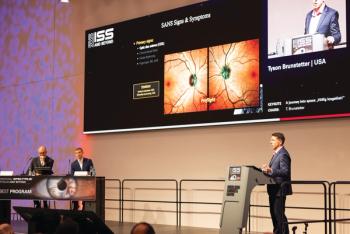
Cross-linking clinical trail outcomes still favourable
Data from an interim analysis
Results from 3 and 6 months of follow-up in a US clinical trial indicate that cornea collagen cross-linking (CXL) is a safe treatment that decreases corneal curvature and thickness and appears to improve vision in eyes with keratoconus or ectasia after LASIK, said Dr Doyle Stulting, PhD.
"Our findings are consistent with data from international experience," said Dr Stulting, professor of ophthalmology and medical director, Emory Vision, Emory University, Atlanta. "Those data also show further improvement in the outcomes with time. We believe this intervention will probably become the standard of care for treatment of corneal ectatic disease and perhaps in preparation for refractive surgery in those at risk for ectasia."
The study has a block-randomized design in which one eligible eye of enrolled patients is assigned to undergo riboflavin/irradiation with ultraviolet-A (UV-A) cross-linking or sham treatment. There is the option for control eyes and untreated fellow eyes to receive the cross-linking treatment after 3 months. Follow-up is planned to 1 year.
The primary outcome measure is change in Kmax measured directly by the proprietary software of a Scheimpflug camera (Pentacam, Oculus). Other efficacy endpoints include average central K, best spectacle-corrected visual acuity, uncorrected visual acuity, methicillin resistant Staphylococcus epidermis (MRSE) and several subjective measures.
Dr Stulting said that 147 eyes had been cross-linked and 145 eyes received the sham treatment. At 3 months, data on all eyes showed a significant difference in Kmax between the treatment group and the control group (delta=0.77 D; p=0.003). Other measures of corneal curvature confirm these results.
The findings of the US clinical trial are consistent with previously reported data from investigators outside of the United States. Additionally, longer term follow-up of treated eyes internationally indicate that the beneficial effect of CXL on corneal curvature and vision continues to improve with time, according to Dr Stulting.
Pachymetry showed a decrease in thickness of treated eyes, compared with control eyes.
"We attribute this to compacting of the cornea by CXL, rather than progression of ectatic disease," Dr Stulting said. "There have not been any significant changes in visual acuity, although there is a trend toward an improvement in best spectacle-treated vision in the treatment group."
The safety review shows just a few complications. These include four (1.2%) infiltrates, of which one was culture positive, one culture negative and two not cultured and presumed noninfectious. In addition, there were four (1.2%) cases of delayed re-epithelialization and one (0.3%) case of uveitis. It is not clear whether this was related to the treatment and it was resolved with a short course of steroids.
"The safety profile is excellent, despite the fact that the epithelium must be removed to achieve good saturation," Dr Stulting concluded.
Newsletter
Get the essential updates shaping the future of pharma manufacturing and compliance—subscribe today to Pharmaceutical Technology and never miss a breakthrough.




